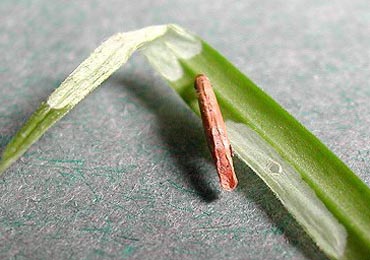|
||||||
|
Coleophora
lithargyrinella Zeller, 1849 Sandy Case-bearer
Coleophora
lithargyrinella Zeller, 1849. Linn. ent. 4:
394 |
||||||||||||||||||||||||||||||||||||||||||||||||||||||||||||||||||||||||||||||||||||||||
Leaf-miner and case-bearer: Larva mines leaves of Caryophyllaceae. The final case is tubular, 8 mm long, with a dorsal keel which forks and continues as two ridges to the anal end of the case (British leafminers). The larval case is very distinctive when fully grown as it is a pale pink colour and has a double dorsal keel (UKMoths). Larva in a trivalved tubular silken case of 8 mm long, with a mouth angle of 25°-30°. The case is pale brown. A unique detail is the presence of a double dorsal keel, but this only occurs when the larva is fully developed: the foremost part of the keel remains single, but already the fork appears before the middle (Bladmineerders van Europa).
Larva: The larvae of moths have a head capsule and chewing mouthparts with opposable mandibles (see video of a gracillarid larva feeding), six thoracic legs and abdominal legs (see examples). Described by Emmet et al. (1996a) (Bladmineerders van Europa). Pupa: The pupae of moths have visible head appendages, wings and legs which lie in sheaths (see examples). Adult: The adult is illustrated in UKMoths. The species is included in mothdissection.co.uk. Hosts in Great Britain and Ireland:
Hosts elsewhere:
Time of year - larvae: May (British leafminers). Time of year - adults: Univoltine - being found in June and July (UKMoths). Distribution in Great Britain and Ireland: Very widespread throughout Britain, but is found sparingly and locally (UKMoths) including Anglesey, Berkshire, Caernarvonshire, Cardiganshire, Denbighshire, Dorset, Herefordshire, Kirkudbrightshire. Merionethshire, Monmouthshire, North Aberdeenshire, North Devon, North Essex, Pembrokeshire, South Essex, West Gloucestershire, West Kent, West Norfolk and West Suffolk (NBN Atlas). It favours two habitats, being found in coastal areas, where Sea campion grows, or woodland - where its foodplant is stitchwort (UKMoths). Also recorded in the Republic of Ireland (Fauna Europaea and National Biodiversity Data Centre Map). Distribution elsewhere: Widespread in continental Europe including Austria, Belgium, Croatia, Cyprus, Czech Republic, Danish mainland, Finland, French mainland, Germany, Hungary, Italian mainland, Latvia, Lithuania, Norwegian mainland, Poland, Romania, Slovakia, Slovenia, Sweden, Switzerland and The Netherlands (Fauna Europaea). NBN Atlas links to known host species:
British and Irish Parasitoids in Britain and elsewhere:
|
||||||||||||||||||||||||||||||||||||||||||||||||||||||||||||||||||||||||||||||||||||||||
| Last updated 11-Jul-2019 Brian Pitkin | ||

